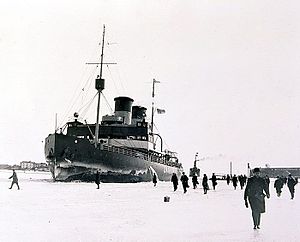Jääkarhu

Jääkarhu arriving in Helsinki in April 1926.
|
|
| History | |
|---|---|
|
|
|
| Name: | Jääkarhu |
| Namesake: | Polar bear |
| Owner: | Finnish Board of Navigation |
| Port of registry: |
Helsinki, |
| Ordered: | 17 April 1924 |
| Builder: | P. Smit Jr. Shipbuilding and Machine Factory, Rotterdam, Netherlands |
| Cost: | |
| Yard number: | 350 |
| Launched: | 26 August 1925 |
| Commissioned: | 2 March 1926 |
| Decommissioned: | 24 February 1945 |
| In service: | 1926–1945 |
| Fate: | Handed over to the Soviet Union |
|
|
|
| Name: | Sibiryakov (Сибиряков) |
| Namesake: | Alexander Mikhaylovich Sibiryakov |
| In service: | 1945–1972 |
| Fate: | Broken up in 1972 |
| General characteristics | |
| Type: | Icebreaker |
| Tonnage: | 2,622 GRT |
| Displacement: | 4,836 tons |
| Length: | |
| Beam: |
|
| Draught: | 6.5 m (21 ft) |
| Boilers: | Eight oil-fired boilers |
| Engines: | Three triple-expansion steam engines 2 × 2,500 ihp (stern); 2,600 ihp (bow) |
| Propulsion: | Three propellers; two in stern and one in bow |
| Speed: | 13.5 knots (25.0 km/h; 15.5 mph) in open water |
| Crew: | 47 |
| Armament: | Armed during the war |
Jääkarhu was a Finnish and later Soviet steam-powered icebreaker. Built in 1926 by P. Smit Jr. Shipbuilding and Machine Factory in Rotterdam, Netherlands, she was the last and largest steam-powered state-owned icebreaker of Finland. After two decades of successful service, Jääkarhu was handed over to the Soviet Union as war reparation in 1945 and renamed Sibiryakov. She remained in service until the 1970s and was broken up in 1972.
When the Treaty of Tartu was signed on 14 October 1920, Finland agreed to return the Russian icebreakers that the Finnish White Guard had seized during the Civil War in 1918. As a result, the largest and most powerful state-owned icebreaker of Finland at that time, Wäinämöinen, was handed over to Estonia in 1922. Since both the size of the ships calling at the Finnish winter ports and the amount of exported goods, especially forest products, had increased considerably since the First World War, there was a definite need for a large and powerful icebreaker. One of the key issues was the beam of the existing icebreakers, 14 metres (46 ft), which was not enough for the new ships used to transport goods across the Atlantic Ocean.
In 1923, the state allocated FIM 10 million for the design and development of a new icebreaker based on the experiences gained during the four years that Wäinämöinen had spent under the Finnish flag. The basic design of the new vessel, which was to have a beam of at least 18 metres (59 ft), was awarded to experienced Finnish naval architects K. Albin Johansson and Ossian Tybeck.
By June 1923, bids ranging from FIM 20.2 to 35.5 million had been received from 24 shipyards representing eight nationalities. The most expensive offer was received from the Finnish Sandvikens Skeppsdocka och Mekaniska Verkstads Ab that was already building another new icebreaker, Voima, in Helsinki. In the end, the contract was awarded to the Dutch shipbuilder P. Smit Jr. Shipbuilding and Machine Factory from Rotterdam. The shipyard had recently constructed four ice-strengthened ships for the Finland Steamship Company and the technical director of the company had personally spent several weeks on board the Finnish icebreaker Sampo during the past winter.
...
Wikipedia
